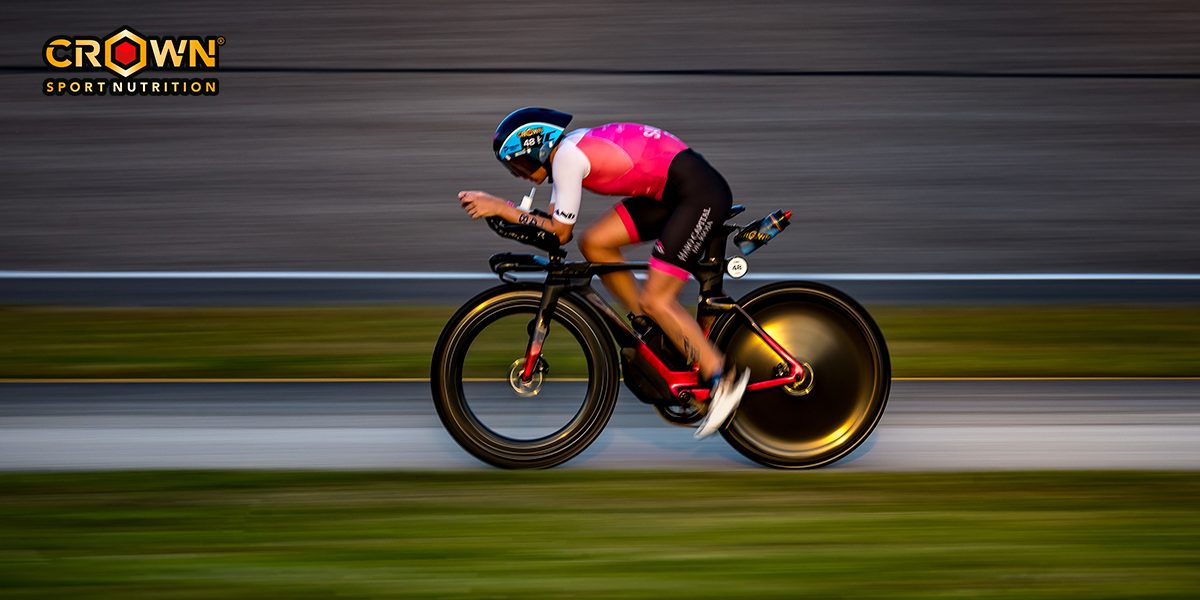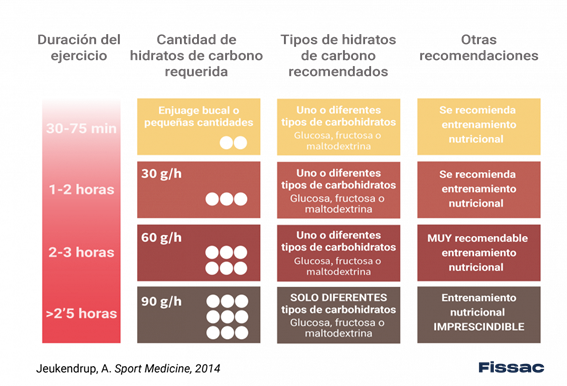Carbohydrates are the main fuel for our muscles during exercise, especially at moderate to high intensities. To use a car engine analogy: when we exercise at low intensity, a large part of the energy we need can be obtained from the “Eco” or electric mode—in our case, from fat. However, as we increase the intensity, we need fast energy—gasoline. In our body, that means metabolizing carbohydrates.
Since glycogen stores are limited—just like a car’s fuel tank—consuming carbohydrates during exercise is an effective strategy to enhance performance and reduce fatigue, as we’ve previously discussed (you can read more about the benefits of carbohydrates for performance and “durability” [here and here]). In fact, the longer and more intense the exercise, the greater the recommendation to increase carbohydrate intake, as shown in Figure 1. But does any type of carbohydrate work?
Figure 1. Carbohydrate intake recommendations during exercise by Jeukendrup (1). Source: www.fissac.com.
The importance of combining different types of carbohydrates
Until just over a decade ago, traditional guidelines recommended consuming around 60 grams of carbohydrates per hour of exercise regardless of duration, based on the assumption that the intestinal and muscular transporters for carbohydrate uptake had a set absorption limit. However, later studies showed that when combining carbohydrates that use different transporters (e.g., glucose and fructose), that limit could be surpassed. For example, various studies led by renowned nutritionist Asker Jeukendrup demonstrated that very high doses (between 108 and 144 g/h) of a glucose-fructose mix allowed greater carbohydrate oxidation and produced superior performance benefits—not only compared to a placebo, but also compared to the same amount of carbohydrate coming solely from glucose (Figure 2) (2,3).

Figure 2. Performance during a time trial in which cyclists consumed a placebo (water), the same amount of carbohydrates from glucose only, or a mix of glucose and fructose (3). Source: www.fissac.com.
Thanks to these findings, we now know that it’s possible to tolerate more than 60 grams of carbohydrates per hour—provided different types of carbohydrates are combined, typically maltodextrin and fructose, or glucose and fructose. In fact, current guidelines recommend consuming up to 90 grams per hour when exercising for more than 2–3 hours. In the professional cycling peloton, even higher intakes are common—reaching or surpassing 120 grams per hour (you can read more about this [here]). But if we need to combine different carbohydrates, what’s the ideal mix?
Carbohydrate ratio and performance
In the studies mentioned above, which showed the benefits of combining different types of carbohydrates, the mix used glucose or maltodextrin with fructose at a 1:0.5 ratio—that is, twice as much glucose or maltodextrin as fructose (e.g., 60g maltodextrin and 30g fructose per hour), commonly referred to as the 2:1 ratio. However, subsequent research explored whether different carbohydrate ratios could enhance these effects. One study in cyclists compared water intake with 108 grams per hour of carbohydrates using different ratios: the classic 1:0.5 (or 2:1), 1:0.8 (80% fructose), and 1:1.25 (25% more fructose than maltodextrin) (4). The results showed that the 1:0.8 ratio not only maximized carbohydrate oxidation during exercise but also resulted in the greatest improvement in peak power during an incremental test (3.6% and 3.0% more power with 1:0.8 and 1:1.25 ratios compared to 1:0.5). Additionally, participants reported fewer instances of nausea and gastrointestinal discomfort with the 1:0.8 ratio.
CONCLUSIONS
For low-intensity, short-duration exercise, carbohydrate requirements are not high, and small amounts (60 grams per hour or even less) of a single carbohydrate source may be sufficient. However, as duration and intensity increase—especially beyond 2–3 hours—it is recommended to aim for 90 grams per hour. To maximize performance benefits and improve tolerance, it’s important to combine different types of carbohydrates, such as maltodextrin and fructose. Among the available options, a 1:0.8 ratio appears to be the most effective for enhancing performance while minimizing gastrointestinal issues.









